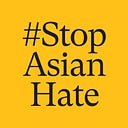What to Do When You See Anti-Asian Harassment Happening
Use the 5Ds. Right To Be co-founder Emily May shares how.
If someone dropped their hat on the street, you’d know what to do. If you saw someone having a medical emergency, you’d know what to do. But when people witness anti-AAPI hate, they freeze. They have no idea what to do.
At the beginning of the pandemic, we were already seeing signs of anti-Asian hate everywhere we looked. One Asian woman was punched in the face by a man asking, “Where’s your mask?”. Days later, a man stabbed an Asian family inside a Sam’s Club because he thought they were “Chinese and spreading the coronavirus.” In the middle of it all, former President Trump famously defended the use of “Chinese virus,” saying “it’s not racist at all.”
Now hate and violence toward AAPI communities are at an all-time high. So is distrust in the police, in the system we’re told to turn to for safety. And so a new solution has arisen: People are learning how to take care of another. In the past two months alone, Right To Be has had over 110,000 people register for the free bystander intervention training that we’re offering in partnership with Asian Americans Advancing Justice (AAJC). Ninety-eight percent of people leave the training feeling confident they will intervene the next time they witness harassment.
You should get trained, too. But if you haven’t yet, here are the basics of how to intervene using Right To Be’s 5Ds of bystander intervention: Distract, Delegate, Document, Delay, and Direct. Four out of the five Ds are indirect, meaning that you won’t be detected by the people doing the harassing, but you’ll still be able to support the person being harassed.
Let’s take a look at what the 5Ds can look like in action:
Distract
Distraction draws attention away from the intensity of the harassment and ultimately de-escalates the situation. For example, you could drop your coffee and people would scramble to help you clean it up or avoid the mess. You could also start a conversation with the person experiencing the harassment. Here, the idea is to build a safe space with the person being harassed while starving the person doing the harassing of the attention they are so desperately seeking.
Delegate
This means finding someone else to help. My favorite person to delegate to is the person right next to me. Like me, they probably have a very human desire to take care of other humans. Unlike me, they probably haven’t written a book on bystander intervention. Asking them to document a situation, intervene directly, or go and grab the manager while you monitor the situation are simple ways to support you, as well as the person being harassed. You can also reach out to the police if you’re in public, your HR department if you’re at work, or the social media platforms if the harassment is occurring online, but it’s best to check in with the person being harassed first.
Document
Whether you’re using your cell phone camera, pen and paper, or saving screenshots and hyperlinks, documentation is powerful. It gives power back to the person being harassed and gives them the reassurance that what happened was wrong, while simultaneously giving them the concrete evidence they will need if they decide to report it.
Delay
Sometimes the harassment is too quick for any other intervention. When this happens, a quick check-in can remind the person that it wasn’t okay, and that anyone would be upset by what just happened. You’re putting them in the driver’s seat to determine what they want to happen next, and showing them that you’ve got their back regardless of what they choose (even if they choose to do nothing).
Direct
Here, you’re setting a boundary with the person doing the harassing, and then turning your attention to the person being harassed. This is the most misunderstood of the 5Ds. We imagine that being “direct” means telling the person off, or at the very least, educating them. But it’s not very much about them at all, or even you for that matter. Like with all the 5Ds, it’s about prioritizing the person being harassed. Refusing to go back and forth with the person doing the harassing and ignoring your own (very human!) desire to show them you are right — is all part of successfully intervening directly.
If you’ve intervened to stop harassment, or you’ve experienced harassment, share your story with us.

